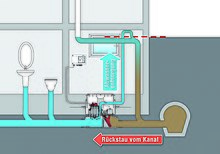Backwater lifting system
A backwater lifting system is a lifting system or a pumping station that basically uses an existing gradient to the sewer to discharge the sewage from the affected drainage objects (shower, washing machine, toilet, etc.). In the event of a backflow, one or more flaps shut off the pipeline to the sewer, and any waste water that occurs is lifted above the backflow level with the help of an integrated pump and passed on to the sewer. Backwater lifting systems or hybrid lifting systems are considered to be economically improved, but above all as ecologically more efficient systems, among other things because they combine the safety of a lifting system with the advantages of backwater protection.
The European standard DIN EN 12056-4 specifies that drainage points below the backflow level are to be secured by automatically operating wastewater lifting systems (with backflow loop). According to Ö-Norm B2501, in addition to the classic sewage lifting system, a backwater lifting system is also permitted.
Ecological background
Conventional lifting systems are in continuous operation and pump the wastewater constantly, thus consuming energy and generating noises. Hybrid lifting systems, on the other hand, are designed in such a way that they are only activated when a backwater event occurs. Above all, this saves operators energy and maintenance work / costs, as wear and tear and noise emissions are significantly reduced.
Technical background
In order to find a suitable lifting system, it is important to determine the type of wastewater via the connected drainage equipment. This can be divided into two categories: Faecal-free wastewater ("gray water") from showers, washing machines, bathtubs, etc. and sewage containing faeces (“black water”) from toilets or urinals. In the case of sewage containing faeces, the installation of special sewage lifting systems is necessary.
Economic background
Hybrid lifting systems minimize the economic risks in the event of unplanned or uncontrollable events such as power outages. In addition, the use of hybrid lifting systems reduces the risk of economic damage as a result of flooding or the like. and wear and tear costs are kept low.
Function and structure
A backwater lifting system is a system consisting of a backflow stop with an upstream overflow to the wastewater lifting system with a collecting space. Drainage takes place:
- without backflow via the backflow stop only by means of gravity and without external energy.
- in the event of backwater via the sewage lifting plant with external energy.
A backwater lifting system normally drains the waste water over the natural gradient to the sewer. One or more flaps shut off the line in the event of a backwater. The integrated pump only switches on automatically in the event of a backflow to lift the wastewater through the backflow loop and then to pump it into the sewer system.
Individual evidence
- ↑ Measures against backflow - backflow protection - building drainage - products - Jung Pumpen GmbH. Accessed on November 13, 2018 (German).
- ↑ Drainage systems for buildings and properties Regulations for planning and execution ÖNORM B 2501. Accessed on November 13, 2018 (German).
- ↑ . Backwater lifting system . In: bba . December 8, 2011 ( bba-online.de [accessed November 13, 2018]).
- ↑ Ulrich Fox: Dirty water drainage . In: Building technology in residential construction . Vieweg + Teubner Verlag, Wiesbaden 1995, ISBN 978-3-8348-1658-0 , p. 36–45 , doi : 10.1007 / 978-3-322-95327-8_4 ( springer.com [accessed November 13, 2018]).
- ↑ Dipl. - Ing. Erwin Nolde: Gray water use in the Arabella - Sheraton Hotel Offenbach . Ed .: Nolde & Partner innovative water concepts. Berlin.
- ↑ Knerr, Henning: Investigations on the composition and degradation of black water by means of the activation process and on the kinetics of heterotrophic and autotrophic metabolism . 2012 ( uni-kl.de [accessed on November 13, 2018]).
- ↑ Henning Knerr: Investigations on the composition and degradation of black water by means of the activation process and on the kinetics of heterotrophic and autotrophic metabolism . Ed .: Technical University of Kaiserslautern. Kaiserslautern.
- ↑ Now with approval: Hybrid lifting system also drains without electricity . In: B_I MEDIA . October 14, 2018 ( bi-medien.de [accessed November 13, 2018]).
- ↑ Lifting systems for pumping dirty water (faeces). Retrieved December 19, 2018 .
